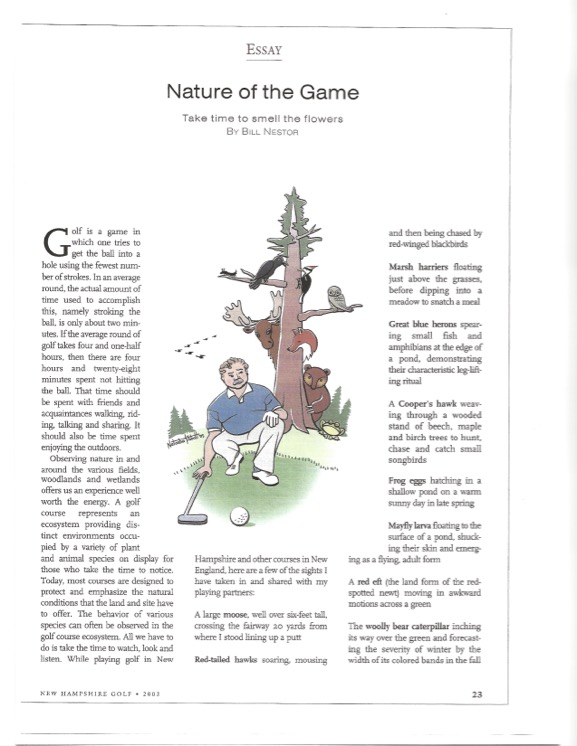June, 2003
Take time to smell the flowers
Golf is a game in which one tries to get the ball into a hole using the fewest number of strokes. In an average round, the actual amount of time used to accomplish this, namely stroking the ball, is only about two minutes. If the average round of golf takes four and one-half hours, then there are four hours and twenty-eight minutes spent not hitting the ball. That time should be spent with friends and acquaintances walking, riding, talking and sharing. It should also be time spent enjoying the outdoors.
Observing nature in and around the various fields, woodlands and wetlands offers us an experience well worth the energy. A golf course represents an ecosystem providing distinct environments occupied by a variety of plant and animal species on display for those who take the time to notice. Today, most courses are designed to protect and emphasize the natural conditions that the land and site have to offer. The behavior of various species can often be observed in the golf course ecosystem. All we have to do is take the time to watch, look and listen. While playing golf in New Jersey and other courses in the Northeast, here are a few of the sights I have taken in and shared with my playing partners:
Honking geese, flying high above in “V” formation, moving with the season’s changes.
Red-tailed hawks soaring, mousing and then being chased by red-winged blackbirds.
Marsh harriers floating just above the grasses, before dipping into a meadow to snatch a meal.
Great blue herons spearing small fish and amphibians at the edge of a pond, demonstrating their characteristic leg-lifting ritual.
A Cooper’s hawk weaving through a wooded stand of beech, maple and birch trees to hunt, chase and catch small songbirds.
Frog eggs hatching in a shallow pond on a warm sunny day in late spring.
Mayfly larva floating to the surface of a pond, shucking their skin and emerging as a flying, adult form.
A red eft (the land form of the red-spotted newt) moving in awkward motions across a green.
The woolly bear caterpillar inching its way over the green and forecasting the severity of winter by the width of its colored bands in the fall.
Chipmunks and squirrels playfully chasing each other in spring as a mating ritual, and gathering acorns to store in fall.
A flock of crows noisily harassing a roosting barred owl, a species known to steal eggs from the nesting crows.
The noisy chatter of arboreal red squirrels flinging themselves from one thin branch to another.
The beautiful melodic song of migrating spring warblers.
The distant drumming of a pileated woodpecker’s repeated jackhammer rhythm and its undulating flight across the fairway.
A large moose, well over six-feet-tall, crossing the fairway 20 yards from where I stood lining up to putt.
The swooping mating ritual of hummingbirds among the blooming honeysuckle.
A young fox frolicking near a golf ball in the middle of a fairway.
A young full-sized brown bear emerging from a wooded stand of hemlocks adjacent to the wetland, stopping to look quizzically at us from the front of the tee box.
A pair of spotted fawns playing in the fescue, while the protective mother doe watched from just within the mature stand of white pines.
These interactions and observations are really what golf and life should be all about. Unfortunately, we spend too much of our lives working at life and too little time living it. If we strive to live our lives like we should play golf, then our day-to-day reality could become an engaging pastime.



